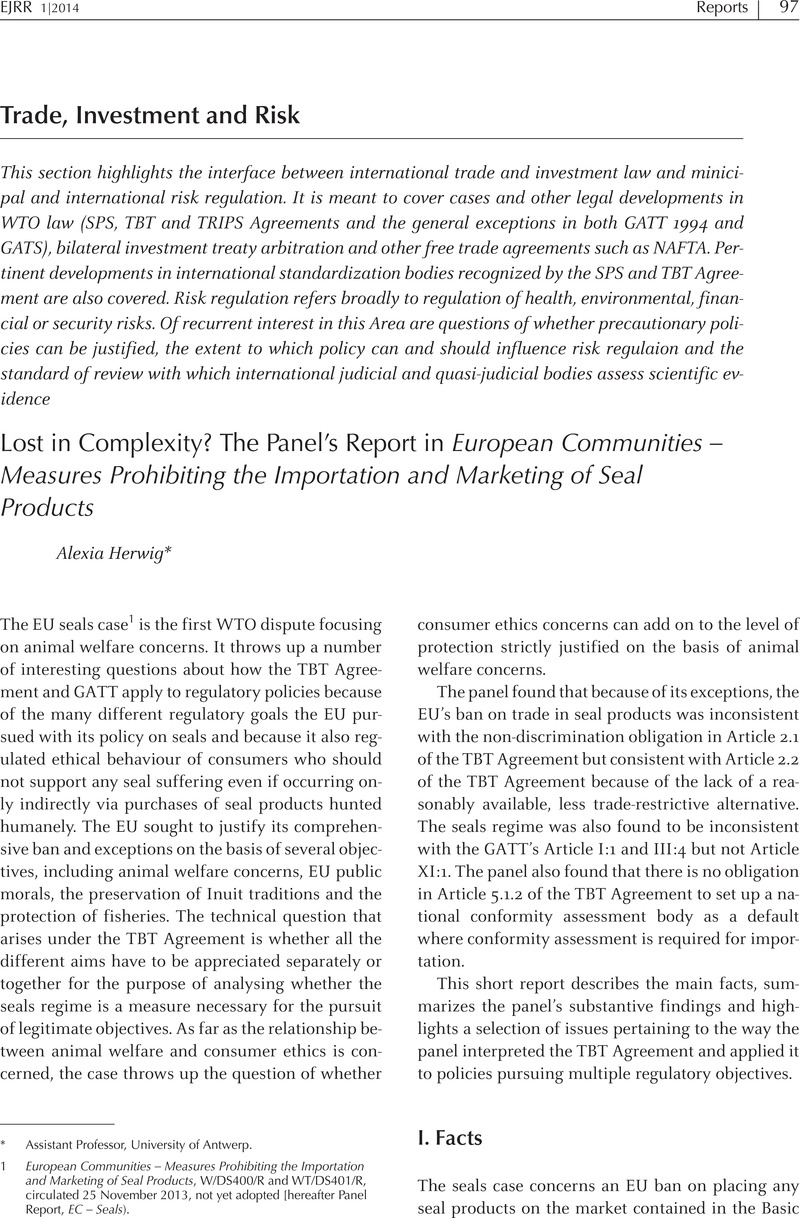No CrossRef data available.
Article contents
Lost in Complexity? The Panel's Report in European Communities – Measures Prohibiting the Importation and Marketing of Seal Products
Published online by Cambridge University Press: 20 January 2017
Abstract

- Type
- Reports
- Information
- Copyright
- Copyright © Cambridge University Press 2014
References
1 European Communities – Measures Prohibiting the Importation and Marketing of Seal Products, W/DS400/R and WT/DS401/R, circulated 25 November 2013, not yet adopted [hereafter Panel Report, EC – Seals).
2 Regulation (EC) No. 1007/2009 of the European Parliament and of the Council, of 16 September 2009 on trade in seal products, 2009 O.J. (L 286) 36, Article 3. This regulation is also called the Basic Regulation. The implementing regulation of the Basic Regulation was also challenged before the panel. Its title is Commission Regulation (EU) No. 737/2010 of 10 August 2010 laying down detailed rules for the implementation of Regulation (EC) No. 1007/2009 of the European Parliament and of the Council on trade in seal products, 2010 O.J. L (216) 1.
3 Panel Report, EC – Seals, para. 7.125.
4 TBT Agreement, Annex 1.1.
5 Panel Report, EC – Seals, paras. 7.7.106, 7.108-7.112.
6 Ibid., para. 7.132.
7 Ibid.
8 Ibid., paras. 7.138-7.140.
9 Ibid., paras. 7.164, 7.168, 7.170.
10 Ibid., paras. 7.185-7.224.
11 Ibid., paras. 7.261-7.271, 7.275,
12 Ibid., para. 7.299-7.300.
13 Ibid., para. 7.282, 7.285-7.289,
14 Ibid., paras. 7.285-7.289, 7.309-7.313., 7.319.
15 Ibid., paras. 7.330-7.331, 7.335, 7.343-7.347, 7/351-7.352.
16 Ibid., para. 7.353.
17 Ibid., paras. 7.386-7.398.
18 Ibid. paras. 7.417-7.418.
19 Ibid., paras. 7.401, 7.402.
20 Ibid., paras. 7.426, 7. 445, 7.447, 7.451-2, 7.453-7.455.
21 Ibid., para. 7.460.
22 Ibid., paras. 7.480-7.482, 7.496-7.497, 7.482, 7.483, 7.499, 7.502.
23 Ibid., para. 7.504.
24 Ibid., para.7.508.
25 Ibid., para. 7. 515.
26 Ibid., para. 7.510.
27 Ibid., paras. 7.522-7.524.
28 Ibid., paras. 7.525-7.528.
29 Ibid., para. 7.539.
30 Ibid., para. 7.545.
31 Ibid., para. 7.546.
32 Ibid., paras. 7.564-7.566, 7.330-7.331, 7.335, 7.343-7.347.
33 Ibid., paras. 7.569-7.580, 7.225-7.245.
34 Ibid., paras. 7.597, 7.599., 7.600.
35 Ibid., paras. 7.607-7.609.
36 Ibid., para. 7.639.
37 Ibid., para. 7.639.
38 Ibid., paras. 7.649-7.651.
39 Ibid., paras. 7.660-7.664.
40 Petros C. Mavroidis, “Driftin’ too far from shore – Why the test for compliance with the TBT Agreement Developed by the WTO Appellate Body is wrong, and what should the AB have done instead.”, World Trade Review (2013), 1-23:7-8, 16-17.
41 Ibid., at 16.
42 Under the TBT Agreement, complainants bear an initial burden to challenge also the regulatory reasonableness of the measure whereas under the GATT, once a measure is found to be provisionally inconsistent with the non-discrimination obligations in Articles I or III, the burden to demonstrate regulatory reasonableness falls to the respondent (except for the suggestion of less trade restrictive alternatives).
43 Perisin argues that a public morals defense should not be available for consumer ethics policies that rest on a misconception about facts of animal suffering, while Howse argues that the EU’s consumer ethics policy should have been upheld. See Tamara Perisin, “Is the EU Seal Products Regulation a Sealed Deal? EU and WTO Challenges”, 62 International & Comparative Law Quarterly (2013), pp. 373-405: 395-396 and Robert Howse and Joanna Langille, “Permitting Pluralism: the Seal Products Dispute and Why the WTO Should Accept Trade Restrictions Justified by Noninstrumental Moral Values”, 37 Yale Journal of International Law (2012), 367–432.




